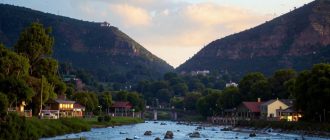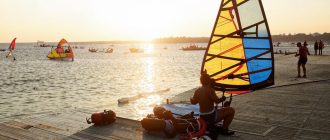
President of Pro-Vision, author of the Vinogradov.story community
Sometimes visa bureaucracy can spoil the impression of a new country even at the stage of preparing for a trip. However, there are quite a few places on the world map where Russians are genuinely welcome: they put a formal stamp right at the border or let you in without a visa at all. I have collected the most exotic of such places in one article.
Galapagos Islands, Ecuador
Entry: visa-free, environmental fee is charged
When we say Galapagos, we remember the legendary tortoises that gave the islands their name. However, turtles are only the most famous, but by no means the only representatives of the amazing fauna of this region. Diving with marine iguanas or the cutest penguins is a quest more serious than a photo safari to the “Big Five”.
At the same time all species get along quite peacefully with each other: sharks, rays, fish and penguins almost childishly frolic and do not compete with each other. In other parts of the world these species are connected links of one food chain, here they are rather friendly neighbors, who are quite comfortable on the common territory.
There are four islands available for independent travel in the Galapagos: Santa Cruz, San Cristobal, Isabella and Floriana. Whichever one you end up on, be sure to check out the local market at dawn. All the Galapagos wildlife, from birds to mammals, will come along with you for a fresh catch. In just half an hour, an Ecuadorian time machine will take you back to the Jurassic period – and you won’t need a visa either.
Himalayas, Nepal and Tibet
Entry: Nepal visa is required on arrival; Tibet can be accessed via Nepal by requesting a permit in Kathmandu.
Getting to the foothills of the Himalayas is a big deal: the mountains are notoriously intolerant of random people. Locals believe that the bark, i.e. the path around one of the sacred natural objects, helps to direct the consciousness towards enlightenment. Visitors from other countries perceive such trekking as an opportunity to test themselves.
I was lucky enough to trek around Mount Kailash in Tibet: 53 km, 21 days on the way (including acclimatization), climbing to 5637 m on the Droolma-La Pass. But the numbers, though impressive, are not the most important thing on this route.
Moving along Tibetan shrines, reciting mantras and directing your thoughts to enlightenment, you completely forget about mortal things. You only notice the change of scenery as you pass through several climatic zones: fir forests become rhododendron forests, flowering meadows become lifeless rocky slopes, and sprawling valleys become snow-covered peaks. By the end of the route, many questions that have long remained unanswered are resolved – which ones, everyone will find out for themselves.
Goa, India
Entry: an electronic visa (e-VISA) can be issued to India.
Goa is a very controversial place even by the standards of contrasting India. Marked by the presence of higher powers, it gives some inexplicable spiritual uplift to absolutely everyone, regardless of religion. Otherwise, how else can one explain that Hinduism, Catholicism, Sikhism and Islam peacefully neighbor in Goa?
Such a number of hypostases of divine presence is rare for a single country, much less a tiny part of it. Goa’s colonial legacy is the majestic Catholic cathedrals you’d expect to see somewhere in the south of Europe – but not by the Indian Ocean. The only time you are reminded that you are still in India is when you encounter cows just outside the basilica steps. And in this diversity all facets of Goa’s spiritual life are intertwined.
El Nido, Philippines
Entry: no visa required, stamped at the border crossing.
The Philippine village of El Nido is known far and wide. It was made famous by Jacques-Yves Cousteau, who called the underwater relief of Palawan Island the most beautiful in the world. And if you want to arouse interest in diving, it is here. World-class dive sites are concentrated between the islands of Palawan, and even sophisticated divers come here for racks.
Coral forests pierce the sea surface, and the serenity of the underwater world is occasionally disturbed by swarms of flashy tropical fish, moray eels and rays, bis turtles and even blacktip sharks. It all looks beautiful and a little dangerous. You don’t want to go up to the surface – except for tasting local seafood, which is not distinguished by exquisite breading or peiring, but can boast undeniable freshness and variety.
Indochina (Cambodia, Vietnam, Laos)
Entry: Visas for all countries are required at the border crossing
For those who are not limited by time, you can combine a trip through the countries of Indochina in one large-scale and long trekking. Start with Vietnam with its famous beaches, floating villages and ancient temple complexes. Cross the Mekong and continue in unfamiliar Laos, marveling at the unfamiliar lifestyle of the locals and shooting endless mountain landscapes one by one.
And for dessert leave Cambodia and Angkor Wat, one of the most grandiose monumental structures on Earth. To see it in its entirety, a few days will not be enough. But this architectural masterpiece of the Khmer people will definitely leave impressions for many years to come.






